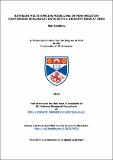Files in this item
Bayesian multi-species modelling of non-negative continuous ecological data with a discrete mass at zero
Item metadata
| dc.contributor.advisor | Buckland, S. T. (Stephen T.) | |
| dc.contributor.author | Swallow, Ben | |
| dc.coverage.spatial | xii, 199 p. | en_US |
| dc.date.accessioned | 2016-10-07T14:37:02Z | |
| dc.date.available | 2016-10-07T14:37:02Z | |
| dc.date.issued | 2015 | |
| dc.identifier | uk.bl.ethos.698462 | |
| dc.identifier.uri | https://hdl.handle.net/10023/9626 | |
| dc.description.abstract | Severe declines in the number of some songbirds over the last 40 years have caused heated debate amongst interested parties. Many factors have been suggested as possible causes for these declines, including an increase in the abundance and distribution of an avian predator, the Eurasian sparrowhawk Accipiter nisus. To test for evidence for a predator effect on the abundance of its prey, we analyse data on 10 species visiting garden bird feeding stations monitored by the British Trust for Ornithology in relation to the abundance of sparrowhawks. We apply Bayesian hierarchical models to data relating to averaged maximum weekly counts from a garden bird monitoring survey. These data are essentially continuous, bounded below by zero, but for many species show a marked spike at zero that many standard distributions would not be able to account for. We use the Tweedie distributions, which for certain areas of parameter space relate to continuous nonnegative distributions with a discrete probability mass at zero, and are hence able to deal with the shape of the empirical distributions of the data. The methods developed in this thesis begin by modelling single prey species independently with an avian predator as a covariate, using MCMC methods to explore parameter and model spaces. This model is then extended to a multiple-prey species model, testing for interactions between species as well as synchrony in their response to environmental factors and unobserved variation. Finally we use a relatively new methodological framework, namely the SPDE approach in the INLA framework, to fit a multi-species spatio-temporal model to the ecological data. The results from the analyses are consistent with the hypothesis that sparrowhawks are suppressing the numbers of some species of birds visiting garden feeding stations. Only the species most susceptible to sparrowhawk predation seem to be affected. | en |
| dc.language.iso | en | en_US |
| dc.publisher | University of St Andrews | |
| dc.subject.lcc | QA279.5S8 | |
| dc.subject.lcsh | Bayesian statistical decision theory | en_US |
| dc.subject.lcsh | Bird populations--Mathematical models | en_US |
| dc.subject.lcsh | Bird populations--Statistical methods | en_US |
| dc.subject.lcsh | Predation (Biology)--Mathematical models | en_US |
| dc.subject.lcsh | Predation (Biology)--Statistical methods | en_US |
| dc.subject.lcsh | Songbirds | en_US |
| dc.title | Bayesian multi-species modelling of non-negative continuous ecological data with a discrete mass at zero | en_US |
| dc.type | Thesis | en_US |
| dc.contributor.sponsor | Natural Environment Research Council (NERC) | en_US |
| dc.contributor.sponsor | Engineering and Physical Sciences Research Council (EPSRC) | en_US |
| dc.contributor.sponsor | National Centre for Statistical Ecology (NCSE) | en_US |
| dc.type.qualificationlevel | Doctoral | en_US |
| dc.type.qualificationname | PhD Doctor of Philosophy | en_US |
| dc.publisher.institution | The University of St Andrews | en_US |
This item appears in the following Collection(s)
Items in the St Andrews Research Repository are protected by copyright, with all rights reserved, unless otherwise indicated.

